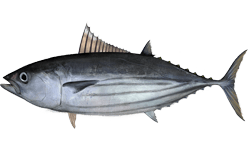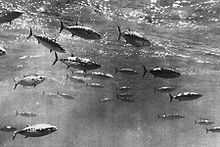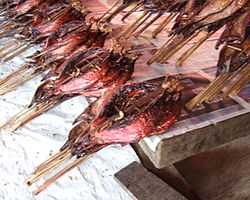Skipjack tuna
| Skipjack tuna | |
|---|---|
 | |
| Conservation status | |
| Scientific classification | |
| Kingdom: | Animalia |
| Phylum: | Chordata |
| Class: | Actinopterygii |
| Order: | Perciformes |
| Family: | Scombridae |
| Subfamily: | Scombrinae |
| Tribe: | Thunnini |
| Genus: | Katsuwonus Kishinouye, 1915 |
| Species: | K. pelamis |
| Binomial name | |
| Katsuwonus pelamis (Linnaeus, 1758) | |
| Synonyms | |
| |
The skipjack tuna, Katsuwonus pelamis, is a medium-sized perciform fish in the tuna family, Scombridae. It is otherwise known as the aku, arctic bonito, mushmouth, oceanic bonito, striped tuna, or victor fish. It grows up to 1 m (3 ft) in length. It is a cosmopolitan pelagic fish found in tropical and warm-temperate waters. It is a very important species for fisheries.[2]
Description

It is a streamlined, fast-swimming pelagic fish, common in tropical waters throughout the world, where it inhabits surface waters in large shoals (up to 50,000 fish), feeding on fish, crustaceans, cephalopods and molluscs. It is an important prey species for large pelagic fishes and sharks. It has no scales, except on the lateral line and the corselet (a band of large, thick scales forming a circle around the body behind the head). It commonly reaches fork lengths up to 80 centimetres (31 in) and a weight of 8–10 kilograms (18–22 lb). Its maximum fork length is 108 centimetres (43 in) and maximum weight is 34.5 kilograms (76 lb). Ageing skipjack tuna is difficult, and the estimates of its potential lifespan range between 8 and 12 years.[2]
Skipjack tuna is a batch spawner. Spawning occurs year-round in equatorial waters, but it gets more and more seasonal further away from the equator. Fork length at first spawning is about 45 centimetres (18 in). It is also known for its potent smell.[2]
Fisheries
It is an important commercial and game fish, usually caught using purse seine nets, and is sold fresh, frozen, canned, dried, salted, and smoked. With reported landings of almost 2.6 mill. tonnes, it was world's 2nd most important capture fish species in 2009.[3] Countries recording large amounts of skipjack catches include the Maldives, France, Spain, Malaysia, Sri Lanka, and Indonesia.[4]
Skipjack is the most fecund of the main commercial tunas, and its population is considered sustainable against its current consumption.[5][6] Its fishing is still controversial due to the methodology; with rod and reel or fishery options being promoted as ecologically preferable.[7][8][9]
Skipjack is considered to have "moderate" mercury contamination. As a result, pregnant women are advised against eating large quantities.[10][11][12]
As food
Skipjack tuna is used extensively in Japanese cuisine, where it is known as katsuo (鰹 or かつお). Besides being eaten seared (katsuo tataki, 鰹のタタキ) and raw in sushi (寿司 or すし) and sashimi (刺身 or さしみ), it is also smoked and dried to make katsuobushi(鰹節 or かつおぶし), the central ingredient in dashi (出汁 or だし) (a common Japanese fish stock). It is also a key ingredient in katsuo no shiokara (塩辛 or しおから).
In Indonesian cuisine, skipjack tuna is known as cakalang. Most popular dish from skipjack tuna is cakalang fufu from Minahasa. It is a cured and smoked skipjack tuna clipped on a bamboo frame.[13] Skipjack is also integral to Maldivian cuisine.[14]
Notes
- ↑ Katsuwonus pelamis (Oceanic Bonito, Oceanic Skipjack, Skipjack, Skipjack Tuna, Skipjack Tuna, Stripy). Iucnredlist.org (2010-09-15). Retrieved on 2013-08-22.
- ↑ 2.0 2.1 2.2 Collette, Bruce B.; Cornelia E. Nauen (1983). FAO species catalogue. Vol. 2. Scombrids of the world. An annotated and illustrated catalogue of tunas, mackerels, bonitos and other related species known to date. FAO Fisheries Synopsis. Rome: Food and Agriculture Organization of the United Nations. p. 137.
- ↑ FAO (Food and Agriculture Organization of the United Nations) (2011). Yearbook of fishery and aquaculture statistics 2009. Capture production. Rome: Food and Agriculture Organization of the United Nations. p. 27.
- ↑ Makoto Miyake, Naozumi Miyabe, Hideki Nakano (2004). Historical trends of tuna catches in the world. FAO Fisheries Technical Paper No. 467. Rome: Food and Agriculture Organization of the United Nations.
- ↑ "FishWatch: Atlantic Skipjack Tuna (Katsuwonus pelamis)". NOAA - National Oceanic and Atmospheric Administration. November 3, 2009. Retrieved 2009-11-12.
- ↑ "Skipjack tuna, purse seine caught". Blue Ocean Institute. Nov 11, 2009. Retrieved 2009-11-12.
- ↑ courtesy of the Secretariat of the Pacific Community (November 2009). "BUSINESS: PACIFIC TOLD TO TAKE THE LEAD If region wants to conserve critical resource". Islands Business International. Retrieved 2009-11-12.
- ↑ "Pacific tries to show way in sustainable tuna fishing". ABC International - Radio Australia. Oct 23, 2009. Retrieved 2009-11-12.
- ↑ "Retailers' Guide to Sustainable and Equitable Pole and Line Skipjack". Greenpeace International. 27 April 2009. Retrieved 2009-11-12.
- ↑ Mercury Levels in Sushi. Americanpregnancy.org. Retrieved on 2013-08-22.
- ↑ Mercury Levels in Fish. NRDC. Retrieved on 2013-08-22.
- ↑ Advice for Pregnant Women on Fish Consumption concerning Mercury Contamination. Mhlw.go.jp (2003-06-03). Retrieved on 2013-08-22.
- ↑ "Cakalang Fufu Jadi Pilihan di Sulut" (in Indonesian). MediaIndonesia.com. 15 July 2011. Retrieved 1 June 2012.
- ↑ Prince, Rose (11 March 2010). "Tuna fishing in the Maldives: the fairest catch". The Telegraph. Retrieved 13 April 2011.
Other references
- Pacific skipjack tuna NOAA FishWatch. Retrieved 5 November 2012.
- Western Atlantic skipjack tuna NOAA FishWatch. Retrieved 5 November 2012.
External links
| Wikimedia Commons has media related to Katsuwonus pelamis. |
| External identifiers for Katsuwonus pelamis | |
|---|---|
| Encyclopedia of Life | 205769 |
| GBIF | 2374191 |
| ITIS | 172401 |
| NCBI | 8226 |
| WoRMS | 127018 |
| Also found in: Wikispecies | |
- "Katsuwonus pelamis". Integrated Taxonomic Information System. Retrieved 24 January 2006.
- Froese, Rainer and Pauly, Daniel, eds. (2005). "Katsuwonus pelamis" in FishBase. 10 2005 version.
- Clover, Charles. 2004. The End of the Line: How overfishing is changing the world and what we eat. Ebury Press, London. ISBN 0-09-189780-7
| ||||||||||||||||||||||
| |||||||||||||||||||||||||||||||||||||





.png)
